The Dominion (Battleford) Telegraph Part II
by Mark Lauckner
Reprinted from "Crown Jewels of the Wire", March 1997, page 4
Numerous attempts have been made in recent years by insulator collectors to
locate this old pioneer threadless line. Wilf & Margaret Secord made
significant discoveries at the location of Wire Cache on the North Thompson
River in 1974, 1975, and in 1983. Many others also dug this site.
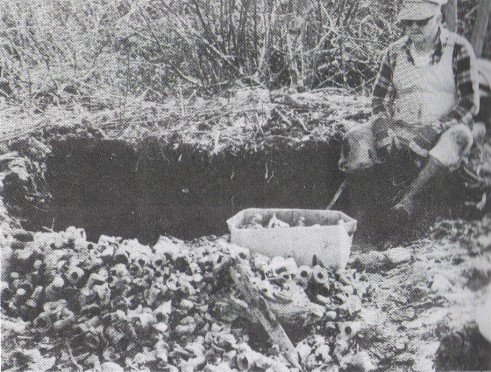
Wilf Secord after 5 days of digging McMicking threadless insulators
at the
site of the old storage cabin in 1983.
(See Wire Cache picture, Crown Jewels of
the Wire, March 1997)
In 1972 Ren Settle of Edmonton discovered perhaps the only known cache of the
small insulators used on the original pioneer line out west. He coined the
phrase "Baby Battleford Threadless" as a nickname for these tiny
insulators. After 3 years research and scratching around on the prairies, he
discovered the location of one of the linemen's cabins on an open wheat field.
After securing permission from the land owner, the team of two diggers worked
for 5 days to fully excavate the area around the foundation of the log and sod
dwelling. Numerous old bottles, battery rests, and other artifacts were recovered along
with several blackglass threadless insulators 5 or 6 feet below the level of the
wheat field.
A total of 124 complete insulators were found, most with some base
damage, along with 170 broken pieces. The insulators were of several different
mold styles, although they were all the same general shape. There were also
10-12 aqua specimens included with the blackglass ones.
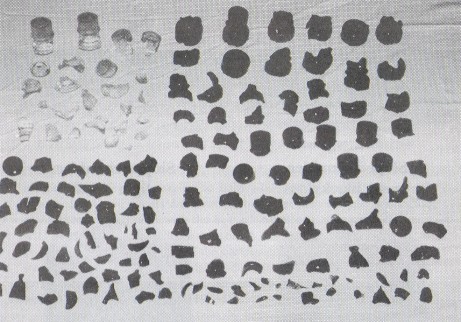
Jigsaw puzzle, anyone?
The broken pieces recovered from the site in 1972.
Of the 5 different mold styles found, 3 are blackglass and two are aqua. The
round-shouldered blackglass variety was recovered complete in smaller quantities
due to the fragile design. The square shouldered variety appears with both a
smooth dome and with a point on the dome. Both were recovered from this line.
The aqua items from this line have also been found with and without the pointed
dome. Aqua specimens have also been recovered in Ontario.
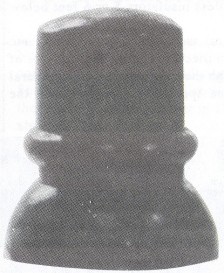
Sloped shoulder,
green blackglass |
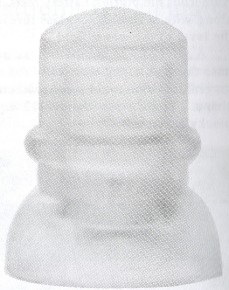
Sloped shoulder,
light aqua |
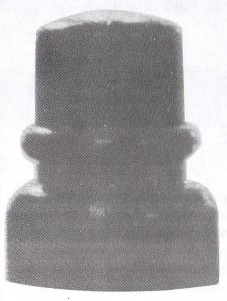
Round shoulder,
green blackglass |
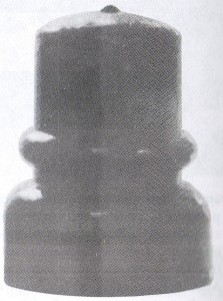
Round shoulder with dot on dome,
green blackglass |
Actual size CD 734.8 Baby Battleford threadless insulators. |
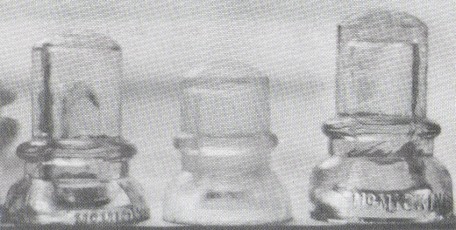
When placed between a short and tall McMicking from the
Wire Cache location,
the profile is very similar but the
Battleford aqua items are must shorter and
more narrow.
In an interview with
Ren Settle, he states:
"Map research, including comparisons with modern
air-photos, and all relevant text materials helped me to zero in on the site I
eventually excavated. Then I had to do a lot of back road driving, and talking
with area farmers, especially the older ones. There's another factor that you
have to deal with as well, and this is difficult because you don't want to offend someone who's trying to help you. Some people "remember"
things, dates, and events differently from what they actually witnessed many
years earlier, and with the best of intentions, may send you on a wild goose
chase. This adds a dimension of "sport" to your research, as you can well
imagine. Most of the cartographic and textual information was made
available to me through the Alberta Provincial Archives in Edmonton, but I had
to pull out the useful bits myself. This took many weekends over the Winter of
1971/72.
The site of the station at Grizzly Bear Coulee in Alberta has been
recognized for its historical importance by the Alberta government since about
1970. It is now officially a protected site. There was abundant evidence that
someone had already made a mess of the site in the search for artifacts back in
the mid-to-late 60's. When my independent research in 1971 showed how important
the site had been to Canadian history, I shared the information with the
Archaeologist (Provincial Archives), and led him to the site, which I had found
on Crown land, and which he had not been able to find the previous summer. It
was, of course, a somewhat disappointing find, due to the sloppy excavation done
earlier. However, John Nicks, the Archaeologist and I spent a weekend mapping
the site for the Archives. But the most interesting episode was yet to come,
because my research had also revealed that the Grizzly Bear Coulee station had
only been used for a few (maybe 2 or 3) years before being abandoned and
relocated a few miles to the West to a site called Eleanor. That was the site I
found and excavated in the early summer of 1972.
The weekend when we were
mapping the Grizzly Bear Coulee site, I shared a pot of coffee over the campfire with the old farmer who resided
closest to the site, still about 2 miles away. He had this wonderfully slow,
laconic manner of speaking, and our conversation, in part, went approximately as
follows:
Ren Settle: So what do you suppose it would have been like, living here
by this little creek back in the 1880's?
FARMER: Well it must' a been real
lonesome 'cause there weren't nobody farm in' around these parts 'till about
ninteen-hunnert-an-ten. (long pause while he rolled a cigarette, then he
continued), But I don't know how they could'uv drank the water from this creek.
It's so alkalai tastin' it'll give you the trots!
RS: What about firewood? Would
they have had enough from the scrubby little poplars growing along the edge of
this coulee?
FARMER: Well, I'll bet they would'uv run right out after a couple
of winters. Them little trees don't grow very fast around here.
These are at
least two good reasons for relocating the station. Still, from what I found at
Eleanor, including "vegetable compound" and "Warner's Safe
Cure" bottles, they didn't leave all their troubles behind.
Eleanor would
have been just a small, sod dwelling/repair-station, measuring no larger than
about 10 by 20 feet, perhaps smaller (easier to heat at 40 below zero).
"Crow-foot" elements from wet-cell batteries indicate they had the
ability to send messages, or at least to boost the signal.
When I first located
the Eleanor Station site, I spent some time talking with the farmer who owned
the land. He would have been in his late seventies at that time, and his memory
relative to the old site, though first-hand, was scanty. His father had
homesteaded the farm (which included the station site) around 1915. He
remembered that he and his father had "kicked a bunch of glass insulators
and stuff' into the depression that remained of the station to fill the hole so
they could till the field without having to detour around it. Once I had his
permission to dig -- before Spring plowing was to start -- I camped at the edge of
the field beside a small pond (the better water-supply?) and talked with the
farmer, on site, about the pattern of his plowing and tilling over the years.
Did he always till that field just in an East/West direction, or did he
sometimes change the pattern?
With this in mind, I began an intensive search of
the surface of the field, and each time I found a piece of glass, I marked the
spot with a survey stake. Within a few hours, I had used all my stakes in an
area about 200 feet square, a relatively small area considering the size of the
field. (By the way, the farmer couldn't pin-point the site any more accurately
than I was trying to do, but he "remembered" it being much closer to
the pond than it actually turned out to be. Then I hired a young friend from
Edmonton to dig with me and camp on the site, and after exploratory trenching
the first two days, we finally hit "pay-dirt". We found the dirt floor
of the station only 3 to 4 feet down. Both the Grizzly Bear Coulee and the Eleanor Station sites showed
evidence of fire in the remains of timbers used to support the roof. I may be
mistaken, but had assumed this to be proof that both structures were torched
during the time of the rebellion in the mid-to-late 1880's in an attempt to
discourage white settlers from the area.
When the dig was underway, we didn't
take any photos, and we kept a very low profile. I think you understand. The
owner would frequently stop by the site, (the large, open grain-field) to inspect
our progress. But he had no idea as to the potential value of what we were
digging up, and we did. We showed him a few insulators, lots of broken glass,
and all the bottles we found, but little else. We certainly didn't want a bunch
of visitors looking over our shoulders! We were on the site actually digging for
five full days. And when we were satisfied that the site had been thoroughly
searched, we refilled the hole as promised, thanked the owner, and left."
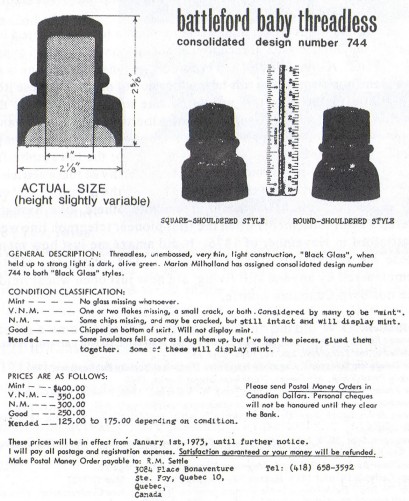
Large Image (181 Kb)
Ren Settle's 1972 Battleford Insulator sale flyer.
Ren Settle sold about 15 of these insulators in 1972-73. He then sold the
entire remaining supply to an insulator collector in Minnesota in 1973.
Two
other people have reported finding these blackglass threadless on the Northern
Canadian prairie. A bottle digger excavating the site of the old Battleford
settlement dump recovered one specimen in 1973. Eight more were recovered at
another dump site more recently and were sold to an insulator collector in
Regina, Saskatchewan. An excavator uncovered them along with numerous broken
pieces while digging the basement for a building in Battleford. I personally
inspected these items earlier in 1996, several badly damaged. Three of them had
the small dot on the dome top, and they were all blackglass in colour. I
advertised heavily in the Battleford area in 1992 and all I came up with was a
farmer who had ploughed up one of the steel pole bases in a field.
Four examples
of the aqua style have also been recovered in the Hamilton, Ontario area in
recent years. One complete green example also exists. As one of the 1874
contracts to construct the line was let to a Hamilton firm, could this be the
location of origin for these items?
While researching this article I came upon
many names that I couldn't find on my 1996 road maps of Alberta and Saskatchewan.
By overlaying my current maps with CPR maps and Northwest Company Trading Post
maps, I was able to place most of the telegraph offices and communities
mentioned in this article. Many of these settlements are still very small today,
like Onion Lake, so the potential still exists for more excavations in the
future. While others, like Saskatoon, weren't even settlements when the first
pioneer telegraph line went to Battleford in November of 1876. It did amaze me
just how many of these old settlements still exist today. The others, too old to
be remembered by anyone still living, are now just open wheat fields on the
northern Canadian prairie.
References:
Canada Before Confederation. R. Cole Harris & John Warkentin,
Oxford University Press,1974
Journal of the Telegraph, Jan. 16, 1880, page 25
The Dominion Telegraph, Canadian Northwest Historical Society Publications, 1930
Wagon Road North, Art Downs, Northwest Digest Books, 1960
The Fraser Canyon,
Valley of Death. Frank W. Anderson, 1968, Frontier Publishing Co.
Canadian
Railway Telegraph History, Robert Burnet, 1996
Crown Jewels of the Wire,
December 1991. Page 12. Fredrick Newton Gisborne 1824-1892 By Eric Halpin.
insulators, Sept. 1972, Information on a Newly Discovered Very Small -Black
Glass+ Insulator. By Ren Settle, Page 25-27.
"Insulator By-Lines" Old Bottle Magazine, September 1973, page 21.
Map: Carleton District 1815, Hudson
Bay Company Archives. Map G. 1/27
Map: Fur Posts and Missions in the Western
Interior. Canada Before Confederation. (See above)
Rand McNally BC, Alberta,
Saskatchewan, and Manitoba road maps.
|
